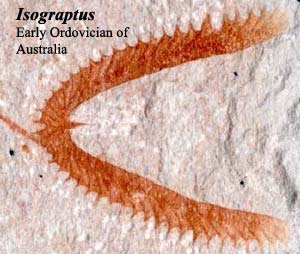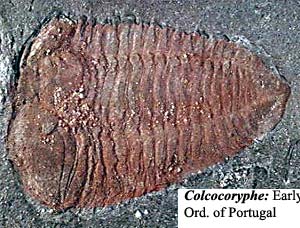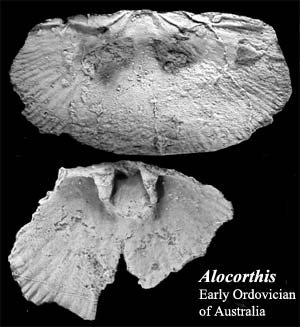The Early Ordovician
The Early Ordovician Epoch: 488 to 472 million years ago
 From the point of view of a hypothetical Late Ordovician oberver, the Early Ordovician was the "good old days." Things were simpler then. It was really just an extension of the Cambrian, but with a new generation of trilobites -- sleeker, probably a bit stronger, but still trilobites. Lots of phylogenetic change was in the air, or actually in the water, but it was mostly happening in the same lush, warm epicontinental seas. Besides, organisms stuck to their roots back then. There were crinoids from Baltica and other crinoids from Laurentia, and yet others from East Gondwana, and you could really tell the difference. None of this messy business with everyone running around everywhere in a totally disorganized fashion. It all would have been just fine if it hadn't been for that worthless Taconic Orogeny. Everything was going along just great, but then Baltica and Laurentia got too close, and suddenly we've got mountains twelve thousand meters high sprouting like mushrooms overnight. Things went to hell pretty fast after that, I'd say.
From the point of view of a hypothetical Late Ordovician oberver, the Early Ordovician was the "good old days." Things were simpler then. It was really just an extension of the Cambrian, but with a new generation of trilobites -- sleeker, probably a bit stronger, but still trilobites. Lots of phylogenetic change was in the air, or actually in the water, but it was mostly happening in the same lush, warm epicontinental seas. Besides, organisms stuck to their roots back then. There were crinoids from Baltica and other crinoids from Laurentia, and yet others from East Gondwana, and you could really tell the difference. None of this messy business with everyone running around everywhere in a totally disorganized fashion. It all would have been just fine if it hadn't been for that worthless Taconic Orogeny. Everything was going along just great, but then Baltica and Laurentia got too close, and suddenly we've got mountains twelve thousand meters high sprouting like mushrooms overnight. Things went to hell pretty fast after that, I'd say.
As in the ramblings of many old-timers (such as ourselves), hypothetical or otherwise, there is both more and less here than meets the eye. Things really were simpler in the Early Ordovician. Metazoan diversity was on the edge of another leap almost comparable to the Cambrian explosion. However, this was a slower matter, and the long run results were mixed. The echinoderms are a good example. Crinoids had evolved well before the Early Ordovician. But during this epoch, they became dominant in many ecosystems on the continental shelves, a dominance they were destined to maintain into the Mid-Jurassic in some regions. Asteroids "star fishes") and ophiuroids "brittle stars") both evolved in the Early Ordovician.  Asteroids didn't become important until the Cretaceous. Ophiuroids have never amounted to much. The Early Ordovician also saw the evolution of two new high-level taxa of blastoids
-- but the entire clade was extinct by the end of the Ordovician. Other novelties of the Early Ordovician met similarly mixed fates, e.g., several new types of articulate brachiopods (Strophomenida & Rhynchonellida) and planktonic graptolites.
Asteroids didn't become important until the Cretaceous. Ophiuroids have never amounted to much. The Early Ordovician also saw the evolution of two new high-level taxa of blastoids
-- but the entire clade was extinct by the end of the Ordovician. Other novelties of the Early Ordovician met similarly mixed fates, e.g., several new types of articulate brachiopods (Strophomenida & Rhynchonellida) and planktonic graptolites.
The world of the Early Ordovician was also much like the Cambrian. Stromatolites were still common. In fact, there had been a moderate resurgance of stromatolites in the Furongian. However, the Early Ordovician was the last epoch in which these massive bacterial colonies would be common. The renewed decline of stromatolites was simply more opportunity for sponges, bryozoans, and corals, who flourished by replacing stromatolites in the Early Ordovician. Similarly, bioturbation of near-shore sediments by annelid worms, bivalves, trilobites and other burrowing forms was not yet universal, and sea bottoms stiffened by algal mats were still relatively common. Again, the Early Ordovician was also probably the last epoch for which this was true.
The fauna of the Early Ordovician was also strongly endemic. In fact, sharp differences between local faunas continued well into the Middle Paleozoic. However, this feature of Paleozoic life was exaggerated in the Early Ordovician due to the wide dispersal of continental cratons in the  temperate and equatorial zones. The exact position of many of the continents remains controversial, probably because of this dispersal. Its hard to tell, for example, precisely where Avalonia and Baltica were in the Early Ordovician, since they weren't in contact with any other land masses. Avalonia and Baltica lay to the south and east of Laurentia. Siberia was to the northeast. The are between them was the broad and loosly confined Iapetus Sea. Further east, poorly known microcontinents were assembling other bits and pieces of what would one day be Asia. Finally, yet further east, Australia and the Chinese terranes formed the tail end of East Gondwana. The rest of Gondwana lay far to the south, as a huge south polar continent. Since no land plants had yet evolved, and Ordovician climates were well stratified from north to south, this was a broad, lifeless barrier to dispersal, not the east-west faunal highway it would become in the Devonian and Late Paleozoic.
temperate and equatorial zones. The exact position of many of the continents remains controversial, probably because of this dispersal. Its hard to tell, for example, precisely where Avalonia and Baltica were in the Early Ordovician, since they weren't in contact with any other land masses. Avalonia and Baltica lay to the south and east of Laurentia. Siberia was to the northeast. The are between them was the broad and loosly confined Iapetus Sea. Further east, poorly known microcontinents were assembling other bits and pieces of what would one day be Asia. Finally, yet further east, Australia and the Chinese terranes formed the tail end of East Gondwana. The rest of Gondwana lay far to the south, as a huge south polar continent. Since no land plants had yet evolved, and Ordovician climates were well stratified from north to south, this was a broad, lifeless barrier to dispersal, not the east-west faunal highway it would become in the Devonian and Late Paleozoic.
Image credits: Isograptus from Geological Society of Australia, Victoria Division. Colcocoryphe from the Paleontological Museum, University of Oslo. Alocorthis from Paterson & Brock (2003).
ATW041125. Text public domain. No rights reserved.

This map is derived from several sources, including two different time slices from Jan Galonka, Dr. Ron Blakey's Paleogeographic Globes, the Paleomap project, and Mac Niocaill et al. (1997). We'd probably put Baltica a bit further east, if we were to do it over again. Note that Laurentia and Baltica are rotated about 90° clockwise from their present orientations.
ATW041124. Map public domain. No rights reserved. An enormous, 2400 x 1200 pixel, unlabelled version of this map is available (free) in all the usual formats, including a Photoshop® *.psd file with each topographical type on a different layer. That one is 8 MB, so you'd best have a fast connection. CD also available for the cost of mailing with various large graphics. Email augwhite@sbcglobal.net.
 From the point of view of a hypothetical Late Ordovician oberver, the Early Ordovician was the "good old days." Things were simpler then. It was really just an extension of the Cambrian, but with a new generation of trilobites -- sleeker, probably a bit stronger, but still trilobites. Lots of phylogenetic change was in the air, or actually in the water, but it was mostly happening in the same lush, warm epicontinental seas. Besides, organisms stuck to their roots back then. There were crinoids from Baltica and other crinoids from Laurentia, and yet others from East Gondwana, and you could really tell the difference. None of this messy business with everyone running around everywhere in a totally disorganized fashion. It all would have been just fine if it hadn't been for that worthless Taconic Orogeny. Everything was going along just great, but then Baltica and Laurentia got too close, and suddenly we've got mountains twelve thousand meters high sprouting like mushrooms overnight. Things went to hell pretty fast after that, I'd say.
From the point of view of a hypothetical Late Ordovician oberver, the Early Ordovician was the "good old days." Things were simpler then. It was really just an extension of the Cambrian, but with a new generation of trilobites -- sleeker, probably a bit stronger, but still trilobites. Lots of phylogenetic change was in the air, or actually in the water, but it was mostly happening in the same lush, warm epicontinental seas. Besides, organisms stuck to their roots back then. There were crinoids from Baltica and other crinoids from Laurentia, and yet others from East Gondwana, and you could really tell the difference. None of this messy business with everyone running around everywhere in a totally disorganized fashion. It all would have been just fine if it hadn't been for that worthless Taconic Orogeny. Everything was going along just great, but then Baltica and Laurentia got too close, and suddenly we've got mountains twelve thousand meters high sprouting like mushrooms overnight. Things went to hell pretty fast after that, I'd say.


